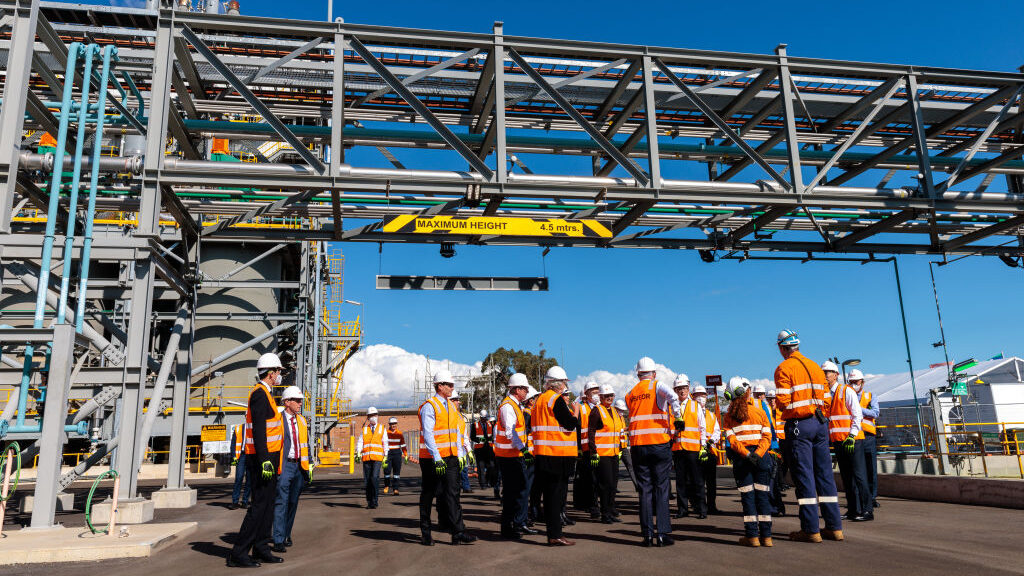BHP joined the rout… so where are the green shoots for nickel now?

Luminaries visited BHP's Nickel West operations as recently as late 2022. Pic: Richard Wainwright - Pool/Getty Images via Getty Images
- BHP flagged the potential closure of its massive Nickel West business yesterday along with a massive $5.4 billion impairment
- Nickel explorer Lunnon Metals says high grade deposits can still make money at current prices
- Centaurus Metals boss Darren Gordon says nickel prices of US$18-20,000/t should be enough to incentivise low cost producers
As BHP (ASX:BHP) wiped as much as $5.4 billion off the value of its 58-year-old Nickel West business and flagged its potential closure, an explorer on the ground floor maintains there will still be opportunities for producers to make money after a price rout caused by a flood in supply from Indonesia.
The rise in supply from the South East Asian, which has lifted from 2-3% of the global market to almost 50% in eight years after banning the export of unprocessed ore in favour of Chinese investment in downstream processing, has seen prices fall from over US$30,000/t in early 2023 to ~US$16,000/t this year.
That has wiped out Australian nickel producers, with Andrew Forrest’s Wyloo Metals, Panoramic Resources (ASX:PAN), First Quantum and IGO (ASX:IGO) all flagging curtailments or mine closures before BHP’s revelation yesterday.
It says the nickel business, elevated to a core asset as the commodity’s role in electric vehicle batteries emerged a few years ago, will lose around US$200 million this financial year.
That could lay waste to plans to invest up to $1.7 billion in the West Musgrave nickel and copper project on the WA-SA border, acquired as part of BHP’s $9.6b deal for OZ Minerals, and what analysts at RBC estimate is a US$750m-1b investment in the rebuild of its Kalgoorlie Nickel Smelter.
BHP’s Kambalda concentrator is already heading into care and maintenance, with its only supplier of nickel ore, Wyloo, heading for mothballs.
But the owner of the region’s next largest high grade nickel resource, Lunnon Metals (ASX:LM8) says Australian nickel producers can still make money at current prices with the right settings.
Having seen his company’s shares fall 10% yesterday on the BHP news, boss Ed Ainscough said the reaction to WA’s nickel explorers had overshot.
“I think typically when things are sentiment driven, they tend to overshoot. This feels like it’s overshot. We’ve seen some green shoots in terms of investor interest, people have said we’re watching for companies with good assets, good management that have been belted too much, and you’re on our list,” Ainscough said on the sidelines of the RIU Explorers Conference yesterday.
“So I see that as a green shoot for a change in the sentiment. It’s probably controversial as a nickel company to say but the Aussie nickel price isn’t that bad if you’ve got the grade.
“I think you and I have spoken in the past about the rule of threes: 1% covers your costs, 1% for payability and recovery and everything above that is your free cash margin. And that still applies.”
Baking in the oven
Lunnon is the second largest resource holder in the historic Kambalda district — where Western Mining Corporation’s discovery of high grade nickel in 1966 sparked Australia’s first nickel boom — after Wyloo.
It boasts resources of around 109,000t, including around 90,600t at 3% nickel at the Baker and Foster projects, never developed in the 2000s nickel revival because they were sold to gold miner Gold Fields.
Ainscough says the company’s high grade Baker discovery could still make $60m at current prices, based on sensitivities used in a pre-feasibility study in May last year.
“If you’re in nickel you need to have assets that can weather that cycle,” he said.
Ainscough noted there were a number of different processing routes it could access with its higher grade ore. ‘Cheekily’ he noted, if BHP really had written down its Kambalda concentrator’s value to zero (with the impairment and rehab provisions BHP’s value on Nickel West is now NEGATIVE US$300m), then Lunnon and Wyloo loomed as logical buyers for the asset.
But he acknowledged BHP’s assessment that the nickel market had changed ‘structurally’.
“It feels like a structural change. I don’t think you go from nothing to 50% of the world’s supply in short order and people are projecting 70% and think that’s going to disappear overnight,” Ainscough said.
“I don’t think that Chinese investors in Indonesia are too worried about the LME. They just want that metal to come back to China. Their end product is a different end product.
“Obviously when we develop something, we want to have a return on investment at the mining level.
“But they’re producing an end product that’s two or three steps further down the track. So really getting that nickel at cost makes no difference. They’re producing those batteries or those cars cheaper than everyone else. So that price point their return is at a different point of the chain.
“I don’t think it’s going away and I think people need to be able to trim their sails and look at their assets and they need to be focusing on the ones that will make money in this kind of environment or be prepared to shutter them.”
Incentive price not far off: Gordon
Despite the sharp fall in nickel prices, Centaurus Metals (ASX:CTM) managing director Darren Gordon said prices aren’t as far from incentive levels as they seem.
The company has almost 1Mt of nickel in the ground at its Jaguar sulphide project at a grade of around 0.87% Ni in Brazil. A DFS is due soon.
“I still think operating cost wise, if you’re talking and concentrate, you probably want to be under US$3 a pound operating cost or somewhere thereabouts,” he said.
“You’re really trying to get into the lowest quartile of cost so that you know that you’re always going to be around even when times are tough.”
He said prices of between US$18-20,000/t could still be enough to support producers.
“Costs have gone up, there’s no doubt. Capital costs have gone up, operating costs have gone up, we’ve been in an inflationary environment,” he said.
“That probably is not going to reverse in a great hurry. You’re going to need a higher price. I think it’s still somewhere in the order of US$18-20,000 a tonne.
“And I think most people would be sort of happy there. Producers would be happy enough there.
“And anyone who’s looking to bring on a project probably needs something like that to make things work.”
While at the moment there is no suggestion a ‘green premium’ for high ESG standard nickel was a real thing, Gordon said discussions with offtakers and OEMs showed they were interested in securing nickel with lower emissions intensity where they could.
“Every conversation that we’ve had with a strategic is still saying longer term we’re going to need the supply and our projects in Brazil, it’s going to come with a low carbon footprint because 80% of Brazil’s grid power’s from renewable sources,” he said.
“So our natural market is in to the US and to the European Union, and those guys haven’t yet had their Gigafactories rolled out, they haven’t quite got the demand side coming, but when that does come, these strategics are still going to be very hungry for low emission footprint product.
“And I think in time, the Indonesian side of it will prove to be a little bit problematic for some of those groups to be participating in that area.”
Lunnon Metals (ASX:LM8) and Centaurus Metals (ASX:CTM) share prices today
Related Topics
UNLOCK INSIGHTS
Discover the untold stories of emerging ASX stocks.
Daily news and expert analysis, it's free to subscribe.
By proceeding, you confirm you understand that we handle personal information in accordance with our Privacy Policy.








